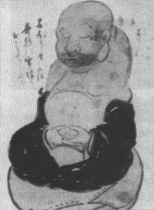About a million years ago I decided to try Zen meditation. I’d been shopping for a spiritual practice for a while. And in the San Francisco Bay Area of the nineteen sixties that meant I had lots of options. And I tried a number of them. But nothing really caught me. But all the time people kept saying, “You should check out the Zen center.”
I’d heard all sorts of things about the master over in San Francisco, Shunryu Suzuki. Many of the things I’d heard were unlikely, some ridiculous. But people also talked about his gentleness and a quiet wisdom that was rare among the spiritual teacher types I had been encountering. And I was told he only taught one practice, something called Zazen. Which I was told meant “seated Zen.” As I was given to understand the word Zen simply meant meditation, it appeared the practice was some kind of meditation one did sitting down.
I figured I can do that.
The Zen center provided basic instruction on Saturday mornings. So my girl friend and I dropped some LSD (did I mention this was the late nineteen sixties?) and hitchhiked from Berkeley over to San Francisco. Fortunately we ended up on Hippy Hill in Golden Gate Park for a delightful day. The following week without chemical assistance or my girlfriend, I caught a couple of busses and made my way to the center.
The center was actually a temple housed in a former Synagogue in Japantown. First, I accidentally wandered into a lower room where some elderly Japanese men were playing Go. They didn’t seem all that happy a young Hippy interrupted them, but they told me how to find my way to the front entrance. Later I would come to learn there was some tension between the Japanese congregation that had brought the roshi over to serve as their pastor, and paid his salary, and the increasing numbers of young people who came to practice Zen.
At the time all I thought was, “Hmm, Go. Perhaps I should learn that, too. If this Zen thing works out.” I began to fantasize about what a Japanese inspired life might look like. I figured it had to be better than what I had.
I don’t recall all the details of that morning, but the details live in my heart. A priest named Claude Dahlenberg gave the small group there that morning the basics.
We were taught how to sit on the traditional pillows. The critical tool was a zafu, a small round pillow, in those days, always stuffed with kapok, a fibrous material that looked a bit like raw cotton. We were shown how to place our bottoms on the front half of the pillow, which caused our legs to naturally fall forward, inclining our knees to the ground. For those of us able to get our knees down, it looked like maybe three of the seven there for the class, this created a triangular base that supported the torso which we were told should be held upright. As we sat our knees and ankles were supported by a second pillow, a larger square of batted cotton called a zabuton upon which both the zafu and meditator rested. In the Japanese style both pillows were black.
We were told the ideal way to sit would be in the full Lotus with each leg folded so the foot rested atop the opposite thigh. None of us could do this. So were shown how to do various modifications, the half lotus with only one foot resting on a thigh and the other placed on the ground slightly forward, the quarter lotus (which Claude sniffed was sometimes called the half ass lotus) where the single foot rested on the calf rather than the thigh, or, finally the way I more or less could sit, where the legs simply were set one in front of the other in what is called the Burmese style.
At the time we weren’t told sometimes people kneel, using that pillow set sideways, or with a special bench. Nor were we told many people also simply sit in chairs. So long as one’s bottom is higher than one’s knees, by placing the feet flat on the ground one could get that same triangular support for the torso.
We were shown how to hold our hands in our laps in a posture called the “cosmic mudra.” We were instructed on how to place the tongue in our mouths, with it resting easily against the upper palate and with our upper and lower teeth touching lightly, but not clenching.
And we were told to sit with our eyes partially open, and with our gaze falling to the ground a couple of feet in front of us. Years later I would hear a teacher when asked whether one should meditate with their eyes open or closed, replied, “Personally, I like to see where I’m going.” This eye’s open style is rare among meditators in other traditions, but the common practice among Zen sitters, as Zen meditators are often called.
Then we were told to count our breaths. Turns out there are many, many ways to count one’s breath. In this style we were instructed to take five breath cycles and put a number on each inhalation and each exhalation. So, inhale: one. Exhale: two. Inhale: three. And so on to ten, and then to start over again.
Again, we weren’t given a lot of additional instruction. Although over the years I learned that some people find it easier to take the whole half breath up with the number. Mentally counting ooooooone for however long it takes to inhale. Twoooooo for however long it takes to exhale. And so on.
Turns out attending to one’s breath and counting inhalations and exhalations can be quite a project. One loses count. One counts robotically, I once got up to sixty-two before noticing.
The deal is to notice the distraction and to return to one.
Just start over.
Turns out there are three principle variations on distraction. The first is to notice one has been distracted and then to blame the environment. It is too noisy outside. The kids are too loud. My neighbor’s belly is making horrible noises. Of course to get into ascribing responsibility for the distraction is simply a meta-distraction. The deal is to notice one has been distracted and to return to one.
Just start over.
Another variation in that meta-distraction is to blame oneself. I’m not smart enough. I don’t have enough discipline. Of course this is simply a variation, turning the blame inside rather than outside. Over the years I’ve noticed there is a slight gender preference in these distractions. I’ll let you guess which prefers which.
Just start over.
And then there’s the third distraction. “But this is a good thought.” You’ve cooked up the plot for the great American novel. You’ve figured out what to say to that annoying co-worker. You have a business plan, finally. Whatever. It’s too good to let go of. Now in fact if its that good it should be recallable later. Most people are only sitting for twenty or thirty or forty minutes. And the deal needs to be, if one wants this to work, is to notice and return. Usually to one.
Just start over.
After getting the basic instructions we were each ushered into an interview with a senior priest. That day Dainin Katagiri, then called by the title sensei, was on duty. I made the bows as I was instructed and sat awkwardly before him.
He asked how long I’d been sitting.
I estimated three, maybe five minutes.
He said, “Good. Keep that mind.”













